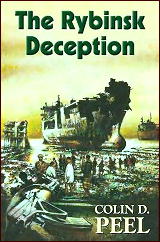Thu 16 Sep 2010
COLIN D. PEEL – Snowtrap. Doubleday Crime Club, US, hardcover, 1985. Hardcover reprint: Detective Book Club, 3-in-1 edition, no date. No paperback edition. First published in the UK: Robert Hale, hardcover, 1981.

A New Zealander by choice and an Englishman by birth, Colin Peel has written at least 15 spy/adventure thrillers since 1973. Of these, this is the only one I’ve read. And if it weren’t the third in this particular volume of a Detective Book Club three-in-one, it might have been a while before the opportunity arose again — of Peel’s sizable output, only two of his novels have been published in the US in paperback (neither one this one).
I say this even though I once upon a time took it upon myself to collect all of the hardcover Doubleday Crime Club mysteries. That was a long time ago, and I probably had a copy at one time, but if I still do, I am embarrassed to say that I could not locate it if I had to.
And as long as I am digressing, let me recommend the DBC editions as a source of (usually) inexpensive detective stories, mysteries and spy adventures like this one, books that never came out in paperback, like this one, and which almost always provide solid and non-negotiable amounts of entertainment, like this one.
And sometimes even more, as the Mignon Warner book (Speak No Evil) reviewed here not so long ago proves, and the one by H. Paul Jeffers (Murder on Mike) as well. That this one’s the lesser of the three does not mean it’s not worth reading. Far from it!
But as far as spy thrillers go, it’s short — only about 190 pages of medium to large-sized print — and even though former military flyer John Vega might have been a character worthy of further (um) characterization, the book’s simply too short to be more than event-oriented.
Vega and Lynne Morrow, the girl (of course) who gets him involved with activities well over his head, are the only people in the story who are more than shadows, and if they were to step sideways, you probably wouldn’t see either one of them either.

It starts with Vega hijacking a Mirage jet at an Australian airport, bombing a nearby uranium mine, and blasting two freighters out of the open sea. It’s one heck of an opening act, that’s for sure, and the twist that quickly snaps back at him is a doozie as well.
What the story needs, and doesn’t quite get, is a finale that’s worthy of these spectacular attention-grabbing devices. Restricted, I’m sure, by the limitations in wordage, set by the markets he was writing for, Peel does his best, but even in 1981 the ending’s one that had been done before, and with the characters so indifferently involved up to then, he simply comes up short, gasping and (figuratively) out of breath.
When you’re competing in Ian Fleming territory, in other words, as an author, you can’t just let it slip away at the end.
[UPDATE] 09-16-10. A better count of Colin Peel’s novels appears to be in the two dozen or so range, including two written under two different pen names. I have not yet determined if all are criminous, a category that includes spy and espionage fiction, but the good news is that as of last year, the author was still writing: The Rybinsk Deception (as seen above) came out in 2009.
September 17th, 2010 at 12:24 pm
I’ll have to look this writer up. There is a small army of writers from Australia and New Zealand we know little or nothing about and some of them are damn good. S. H. Coulter’s MURDERER’S BURNING comes to mind.
RE DBC there was a tendency to look down on them much like READER’S DIGEST, but I bet I have fifty or sixty of them lying around and because so many of the books they printed either never came out in paperback or were rare they are valuable to me. My copy of Lester Dent’s DEAD AT THE TAKE OFF is in a DBC, and there is a Vera Caspary book that I think ‘only’ appeared in novel form in a DBC edition (MURDER AT THE STORK CLUB?). I know this is where I read several of Ken Crossen’s Kim Locke books, met Meynell’s Hooky Heffernan, and encountered quite a few good writers and series that either had no paperback or little paperback presence.
For a long time they were my only source of Bill Knox’s excellent Webb Carrick series about the adventures of the Fisheries Protection Service (yes, the Fish Police). They were also always a good source for Simenon and Maigret.
They really were a bargain, not particularly attractive, but the right size, well bound, and on good paper, with three good novels in virtually every collection, and all for a bit over a buck.
Of course they famously played a bit fast and loose with some writers — even censoring some of Gardner’s Donald Lam stories (can’t think of the title off hand, it’s the one where the girl rips off her bra and screams rape to frame Lam — in the DBC edition its hard to tell what the fuss is about). But that said they were a source for a small town kid with limited bookstore and library choices to read books I probably would never have even heard of. For that I will always have pleasant memories of them.
And even today at the local yearly library sale I always check out the table of DBC and READER’S DIGEST books. Once in a while you get a pleasant surprise.
September 17th, 2010 at 5:06 pm
We are in complete agreement on these Detective Book Club 3-in-1 volumes, and for all the reasons you say.
They often provide, even today, the easiest way to get reading copies of many, many books. But as you also pointed out, you do have to put up with the editing they did, probably not often — certainly not all the time — but one I definitely noticed occurred when large chunks of a James Bond novel simply disappeared a trace.
In the beginning the production values were very good. The wartime books (and those before) often still have white pages. But by the time the 1970s came along, they must have started to cut corners. As the glue they used has hardened and become brittle, chunks of pages become separated and come loose from the binding unless you handle them very carefully.
I think they raised the prices in the 1980s, as I’ve not seen the same problems occurring in later years. Not yet, anyway.
And yes, DBC did some original novels, and some first editions of novels and collections that first appeared in England.
I’ve excluded titles changes and in at least one case, a byline change, but using Hubin as a guide, here’s what I’ve come up with:
Detective Book Club
1946: The Murder in the Stork Club, Vera Caspary. FIRST EDITION
1949: The Department of Dead Ends, Roy Vickers. FIRST US EDITION
1951: The Sole Survivor and The Kynsard Affair, Roy Vickers. FIRST US EDITION
1953: Utter Death, John Hymers. FIRST US EDITION
1954: Murder Most Familiar, Marjorie Bremner. FIRST US EDITION
1954: Dead Man’s Shoes, Michael Innes. [FIRST THUS: SLIGHTLY DIFFERENT STORY SELECTION]
1954: Murder Will Out, Roy Vickers. FIRST US EDITION [WITH ONE ADDITIONAL STORY]
1955: Double Image and Other Stories, Roy Vickers. FIRST US EDITION
1958: The Famous McGarry Stories, Matt Taylor. FIRST EDITION
1958: Six Murders in the Suburbs, Roy Vickers. FIRST US EDITION [OMITTING TWO STORIES]
1959: The Black Gold Murders, John B. Ethan. FIRST EDITION
1959: The Big Blackout, Don Tracy. FIRST EDITION
1959: The Girl Who Wouldn’t Talk, Roy Vickers. FIRST US EDITION
1959: Seven Chose Murder, Roy Vickers. FIRST US EDITION